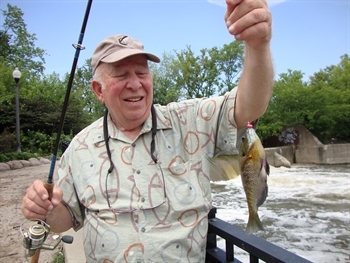
What Our Water's Worth is a campaign led by the Metropolitan Planning Council and Openlands to raise awareness about the value of water in northeastern Illinois and northwestern Indiana.
Hall of Fame fisherman sees Chicago River as 'jewel in the rough'

Angler Don Dubin shows off a fish he caught from the Chicago River, which he calls "a jewel in the rough waiting to be discovered." (Photo by Emily Cikanek)
To say 72-year-old Don Dubin is passionate about fishing is a vast understatement. A Fishing Hall of Fame "Legendary Angler" and an inductee into the Illinois Outdoor Conservation Hall of Fame, he is also a founding member of local fishing organizations Salmon Unlimited and Muskies, Inc., and sits on the Fishing Advisory Boards for the Shedd Aquarium and City of Chicago.
An angler for more than 60 years, Dubin has fished all over the world, but he claims that the best and most diverse fishing is right here in northeastern Illinois. In addition to the cold water fishery of Lake Michigan, “the Chicago River is a fantastic fishery. It’s a jewel in the rough waiting to be discovered,” he says.
True to his claim, he tosses a line into the river at Chicago’s River Park near Foster and Kedzie, and in less than a minute he has reeled in a bluegill. With a gleam in his eye from hooking the first fish of the day, Dubin muses that the Chicago area has an incredibly valuable, but largely untapped, resource on its hands. Dubin is genuinely excited: “Where else can you find the potential for a world-class warm water fishery – right here in the middle of the city?”
Even though he still cannot eat the fish he catches from the Chicago River, the improvements Dubin has seen over his angling career gives him great hope and high expectations for this jewel in the rough. “It’s a great resource that we are just touching right now,” Dubin says. “So I welcome changes. It would be great for the people of Chicago.”
Disinfection is one important step to improving the quality and safety of the Chicago River for recreational users. Read about how far the river has come, as well as the challenges it still faces in this month's What Our Water's Worth.
Conservation tips
The waterways are for water. Lots of things that don’t belong there end up in the river, such as litter, pharmaceuticals, fertilizers and detergents. Buy products with less packaging and fewer pollutants, then dispose of them properly.
Conserve water during storms. When it rains, stormwater flows into the sewer and can overwhelm the system, leading to flooding. Just before, during, and immediately after rain, limit your water use—don’t water your lawn, wash your car, run the dishwasher, etc.—because those small actions contribute to overwhelming the sewer system.
Tell the State to protect people and wildlife. For the first time in almost 40 years, the State of Illinois is considering how to better protect both people that recreate and wildlife that live in and along Chicago’s Rivers. Tell the State that you use and value these waterways, and that they need to act now to protect them for future generations.
June 2011
www.chicagolandh2o.org
What Our Water's Worth is a campaign led by the Metropolitan Planning Council and Openlands to raise awareness about the value of water in northeastern Illinois and northwestern Indiana. From Lake Michigan to the Fox River, how we use our water resources—including what we conserve, how much we waste, and what we choose to invest in water quality—is up to each of us. This is our water—and it's worth more than we know.
WOWW factors
$.90 per month per household
U.S. EPA’s estimate for the average increase homeowners would pay per month for MWRD to build disinfection systems at their Calumet and Northside plants (less than most cups of coffee). This estimate does not factor in Sen. Dick Durbin's (D-Ill.) pledge of federal assistance.
$3.76 billion
Estimated cost to build the TARP Deep Tunnel Project to reduce combined sewer overflows into Chicago waterways. Approximately $2.9 billion has been spent on the project to date, according to the Dec. 1, 2008, TARP Status Report.
> 70 fish species
inhabit the Chicago Area Waterways (CAWS), up from only 10 different fish species that were in CAWS 30 years ago.
$38.2 million
Combined cost to construct the five MWRD Sidestream Elevated Pool Aeration (SEPA) stations, which helped bring back a wider variety of fish to the Chicago waterways by infusing the water with more oxygen. According to the MWRD web site, these “waterfalls create a healthier waterway and are an attractive addition to the riverbank.”
What Our Water's Worth is a monthly e-newsletter. Tell us what you think. Email info@chicagolandh2o.org with feedback in the subject.
To subscribe, visit our website at chicagolandh2o.org.

|
Metropolitan Planning Council
140 S Dearborn St | Suite 1400 | Chicago, IL 60603 Phone (312) 922-5616 phone | Fax (312) 922-5619 |
Openlands
25 E. Washington St. | Suite 1650 | Chicago, IL 60602 Phone: 312-863-6250 | Fax 312-427-6251 |
Copyright © 2026. All rights reserved. | info@chicagolandh2o.org
To stop receiving this newsletter visit metroplanning.org/unsubscribe.html?EmailMsgId=127&email=
